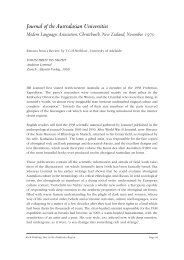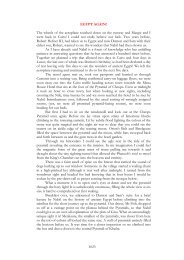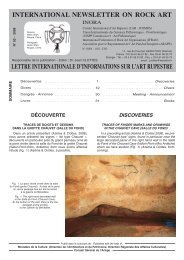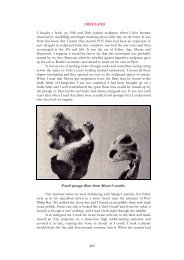international newsletter on rock art lettre internationale d ...
international newsletter on rock art lettre internationale d ...
international newsletter on rock art lettre internationale d ...
Create successful ePaper yourself
Turn your PDF publications into a flip-book with our unique Google optimized e-Paper software.
Les serpents identifiables, à savoir ceux d<strong>on</strong>t la tête<br />
est indiquée (fig. 8.ru), ne représentent que 10 % de l’ensemble<br />
des zoomorphes mais certaines lignes <strong>on</strong>dulées,<br />
classées parmi les signes, pourraient corresp<strong>on</strong>dre à des<br />
serpents stylisés.<br />
Certains animaux n’<strong>on</strong>t pu être identifiés : il pourrait<br />
s’agir d’animaux composites (fig. 8.lm). L’un d’eux, bicéphale,<br />
tient à la fois du serpent et du félin (fig. 8.vw). Cette<br />
combinais<strong>on</strong>, d<strong>on</strong>t l’appariti<strong>on</strong> rem<strong>on</strong>te à l’horiz<strong>on</strong> ancien,<br />
a c<strong>on</strong>nu une distributi<strong>on</strong> très large, du nord-ouest du<br />
Pérou au nord-ouest de l’Argentine. Dans l’<strong>art</strong> rupestre de<br />
Tarija, le corps sinueux du serpent est c<strong>on</strong>stitué d’une<br />
courbe c<strong>on</strong>vexe comprise entre deux courbes c<strong>on</strong>caves<br />
d<strong>on</strong>t les extrémités se relèvent pour s’enrouler vers l’intérieur.<br />
De chaque côté, deux petits traits, accolés aux spirales<br />
ainsi formées, semblent figurer des mâchoires<br />
ouvertes, dépourvues de dents. Un peu plus bas, apparaît<br />
une patte pliée qui s’achève par trois traits évoquant des<br />
doigts ou des griffes.<br />
Les figures anthropomorphes s<strong>on</strong>t très diversifiées<br />
(fig. 9). Presque toutes s<strong>on</strong>t préhispaniques, à l’excepti<strong>on</strong><br />
de quelques cavaliers de l’époque col<strong>on</strong>iale, auxquels s’ajoutent<br />
une femme nue et un homme en costume à la facture<br />
récente. La plup<strong>art</strong> s<strong>on</strong>t debout et vus de face. Les<br />
bras filiformes s<strong>on</strong>t pliés et rabattus dans le plan. Les jambes<br />
s<strong>on</strong>t droites, courbes ou pliées en angle droit. Les<br />
figures de profil s<strong>on</strong>t rares et réservées à des positi<strong>on</strong>s<br />
difficiles à rendre de face (individus assis ou agenouillés,<br />
pers<strong>on</strong>nages ithyphalliques et archers). La tête est généralement<br />
petite mais sa forme varie. Elle est tantôt pleine,<br />
tantôt réservée ; dans ce cas, les traits du visage s<strong>on</strong>t<br />
presque toujours indiqués. Le cou est représenté par un<br />
ou deux traits parallèles. Le torse est filiforme, ovale ou<br />
rectangulaire. Certains pers<strong>on</strong>nages s<strong>on</strong>t vêtus d’une<br />
tunique ornée de motifs géométriques évoquant l’uncu<br />
des hauts dignitaires incas. D’autres se caractérisent par<br />
le port d’ornements d’oreilles, d’une arme, d’un insigne ou<br />
d’une coiffe généralement faite d’appendices droits disposés<br />
en ray<strong>on</strong>s autour du crâne. Les attributs sexuels s<strong>on</strong>t<br />
rarement représentés. Le pénis est indiqué par un simple<br />
trait, parfois relié à un cercle corresp<strong>on</strong>dant au gland. Le<br />
pubis est figuré par un triangle entourant une cupule ou un<br />
sill<strong>on</strong> vulvaire. En l’absence de ces éléments, il est difficile<br />
de déterminer le genre des pers<strong>on</strong>nages, à moins de pouvoir<br />
le déduire des vêtements ou des objets associés. Les<br />
pieds s<strong>on</strong>t absents, marqués par un simple trait ou pourvus<br />
d’orteils. Dans certains cas, les doigts des mains s<strong>on</strong>t<br />
indiqués. L’une des figures les plus p<strong>art</strong>iculières est un<br />
grand pers<strong>on</strong>nage représenté de face, d<strong>on</strong>t le tr<strong>on</strong>c et la<br />
tête s<strong>on</strong>t penchés sur le côté (fig. 10a). Les jambes s<strong>on</strong>t<br />
légèrement fléchies, les bras pliés vers le haut, et les<br />
mains, munies de cinq doigts, encadrent le bas du visage.<br />
La tête, à l’intérieur de laquelle apparaissent les yeux, le<br />
nez et la bouche, est couverte d’une calotte hémisphérique<br />
évoquant le casque porté lors des tincus (combats<br />
rituels) dans la régi<strong>on</strong> d’Uyuni. Cette positi<strong>on</strong> très p<strong>art</strong>iculière<br />
se retrouve sur certains tissages découverts sur la<br />
côte péruvienne, où deux pers<strong>on</strong>nages, disposés symétriquement,<br />
semblent s’affr<strong>on</strong>ter (fig. 10b).<br />
Les gravures s<strong>on</strong>t piquetées ; elles s<strong>on</strong>t rarement regravées<br />
et nous n’av<strong>on</strong>s retrouvé aucune trace d’incisi<strong>on</strong>. Les<br />
gravures préhispaniques s<strong>on</strong>t généralement exécutées<br />
avec soin : le piquetage est c<strong>on</strong>tinu, les bords réguliers ; la<br />
forme des impacts varie mais ceux-ci s<strong>on</strong>t petits et serrés.<br />
Le piquetage disc<strong>on</strong>tinu s’associe à un registre ic<strong>on</strong>ographique<br />
postérieur à la c<strong>on</strong>quête espagnole, comprenant<br />
des chevaux, des cavaliers, des <strong>lettre</strong>s et croix latines. Il<br />
arrive assez fréquemment que des graphèmes corresp<strong>on</strong>-<br />
The identifiable serpents, those with the head indicated<br />
(Fig. 8.ru), <strong>on</strong>ly represent 10% of all the zoomorphic<br />
figures, but certain undulating lines, classed am<strong>on</strong>g the<br />
signs, could in fact corresp<strong>on</strong>d to stylised snakes.<br />
Certain animals could not be identified: they could be<br />
composite animals (Fig. 8.lm). One of them, with two<br />
heads, suggests both a serpent and a feline (Fig. 8.vw).<br />
This combinati<strong>on</strong>, which appears in an early period, was<br />
very widely distributed, from the north-west of Peru to the<br />
north-west of Argentina. In the Tarija <strong>rock</strong> <strong>art</strong>, the serpent’s<br />
sinuous body is made up of a c<strong>on</strong>vex curve between two<br />
c<strong>on</strong>cave curves whose extremities turn up to coil towards<br />
the interior. On each side, two small lines, joined to the<br />
spirals thus formed seem to represent toothless open<br />
jaws. A little lower, there is a folded leg which finishes in<br />
three lines suggesting fingers or claws.<br />
The anthropomorphic figures are very diverse (Fig. 9).<br />
Nearly all are Prehispanic, ap<strong>art</strong> from some horsemen<br />
from the col<strong>on</strong>ial period, to which are added a nude<br />
woman and in a man in recent clothing. Most are upright<br />
and seen from the fr<strong>on</strong>t. The filiform arms seem bent<br />
downwards in the drawing. The legs are straight, curved or<br />
bent in a right angle. Profiles are rare and reserved for two<br />
positi<strong>on</strong>s that are difficult to show face <strong>on</strong> (sitting or kneeling<br />
individuals, ithyphallic figures and archers). The head<br />
is generally small, but its form varies. It is sometimes full,<br />
sometimes not; in this case, the traits of the face are<br />
nearly always shown. The neck is represented by <strong>on</strong>e or<br />
two parallel lines. The torso is filiform, oval or rectangular.<br />
Certain figures wear a tunic decorated with geometric<br />
motifs reminiscent of the uncu of Inca high dignitaries.<br />
Others are characterised by the wearing of ear ornaments,<br />
a weap<strong>on</strong>, an insignia or a hairstyle generally<br />
made up of straight appendages disposed in rays or<br />
spokes around the skull. Sexual attributes are rarely represented.<br />
The penis is indicated by a simple line, sometimes<br />
linked to a circle corresp<strong>on</strong>ding to the glans. The<br />
pubis is represented by a triangle c<strong>on</strong>taining a cupule or<br />
the cleft of the vulva. Without these elements it is difficult<br />
to determine the sex of the character represented, unless<br />
it is possible to deduce it from the clothes of the pers<strong>on</strong> or<br />
from associated objects. There are no feet shown, <strong>on</strong>ly a<br />
simple line or toes suggest them. In certain cases, fingers<br />
are indicated <strong>on</strong> the hands. One of the most noticeable figures<br />
is a large pers<strong>on</strong> shown face <strong>on</strong>, with the trunk and<br />
head leaning to the side (Fig. 10a). The legs are slightly<br />
flexed, the arms bent upwards, and the hands, with five<br />
fingers, frame the bottom of the face. The head, with the<br />
eyes, nose and mouth represented in the interior, is covered<br />
with a hemispherical skullcap reminiscent of the helmet<br />
worn during the tincus (ritual combats) in the Uyuni<br />
regi<strong>on</strong>. This very special positi<strong>on</strong> is found <strong>on</strong> certain<br />
woven cloths that have been discovered <strong>on</strong> the Peruvian<br />
coast where two figures, that have been symmetrically<br />
positi<strong>on</strong>ed, seem to c<strong>on</strong>fr<strong>on</strong>t each other (Fig. 10b).<br />
The engravings are pecked out; they are rarely reengraved<br />
and we have found no trace of incisi<strong>on</strong>s.<br />
Prehispanic engravings are generally carefully d<strong>on</strong>e: the<br />
pecking out is c<strong>on</strong>tinuous, the edges are regular; the form<br />
of the impacts varies, but they are small and close<br />
together. Disc<strong>on</strong>tinuous pecking out is associated with an<br />
ic<strong>on</strong>ographic register that is later than the Spanish c<strong>on</strong>quest,<br />
which includes horses, riders, letters and Latin<br />
crosses. It is rather frequent that graphemes from different<br />
22<br />
INORA, 2009, N° 53







